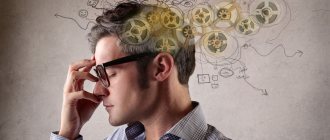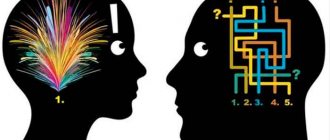Features of science
Decision making is a complex thought process that involves several actions:
- awareness of the current situation;
- goal setting;
- selection of means to implement the plan;
- realization of the goal.
People rarely make choices in a calm environment. They are influenced by irritating factors that change the final decision. The result depends on the motives, goals, and the individual’s belief in his own rightness. If there is a person nearby who is an authority for the doubter, he will influence his answer.
Don't act rashly
Sometimes the best assistant in making a decision is time. Sometimes the only sure way to get rid of emotions is to just wait.
For some, an hour is enough, for others it will take a couple of days. The most important thing is to distract yourself and try to do something else.
But this method has a drawback - it only works when circumstances allow you to take your time. If you are short on time, this method will not work.
Individual preferences
A separate term is “preference”. Merriam-Webster describes it as a disposition related to worldview and temperament. Preferences are formed gradually throughout life. Therefore, people do not remember attachment to things, food.
Preferences can be unconscious or conscious. There are 4 factors that influence unconscious decision making:
- First impression. If a person bought bread for $1, = when he sees it for $0.5, he will purchase the cheap option. If the price was $1.5, then $1 would be a good deal. Marketers use this psychological technique.
- The influence of the environment. Scientists who study the psychological side of decision making call this factor “herd mentality.” An example of this is a newcomer to a team who gradually accepts the opinions of others, their habits, and interests. People do this so as not to stand out from the crowd.
- Fear of loss. People are afraid to lose.
- Context of presenting the situation. The choice depends on the method of presenting relevant information.
Decision making: stages, methods, mistakes
Every day we make dozens of decisions, ranging from the simplest (what time to get up, what to cook for breakfast and whether to have breakfast at all) to the most complex (how to develop a project, who to appoint as responsible and how to get funding). Often a lot depends on one decision or another. Especially when it comes to business - after all, there are a lot of interested parties and various risks. In such cases, it is important to follow certain decision rules. In this article, we will talk about the stages of decision making, decision making methods and errors that occur in the decision making process .
Decision making is choosing the best option from two or more possible ones using certain rules.
These rules consist in following the sequence of decision-making stages. There are five of them in total, one of which (implementation control) is end-to-end - i.e. it appears at all other stages. Let's take a closer look at them.
1. Definition and formulation of the problem.
Decision-making begins when you understand that the current situation does not suit you and it cannot be changed with the help of the means, knowledge and experience that are currently at your disposal. As a rule, you also experience negative emotions.
In order to move on to the decision-making process, it is necessary to formulate the problem. At the same time, problems are usually described from a negative side, indicating what exactly does not suit or hinders the implementation of plans.
For example, “I can’t learn a second language. It doesn’t work out, I don’t have time, etc.”
2. Formulation of the desired solution.
To set a goal and formulate a task, it is necessary to determine the desired result. To do this, you need to describe the desired solution, which is implemented under the most favorable circumstances and the absence of interference and obstacles. This ideal solution will serve as the source of decision criteria. The criterion is the answer to the question: “how will I know that the problem has been solved?”
For example, the decision to learn a second language to a conversational level. Criterion: I will be able to communicate with a native speaker of this language on vacation in the summer of 2013.
3. Definition of conditions and restrictions.
After a desire has been formulated, you need to decide what to focus on: in accordance with what values, norms and rules you will make a decision.
For example, for one organization, the value and norm may be the joint adoption and discussion of decisions by management and top managers, while in another, the sole decision-making by the manager and its unquestioning execution by employees. Here it is necessary and possible to take into account the values, rules and norms shared both by the organization and directly by the decision makers.
In addition, any decision involves gains and losses. Therefore, it is necessary to evaluate possible gains and losses if the decision is implemented.
For example, values and norms: knowledge of a second language today favorably emphasizes my advantages over employers; knowledge of a second language is encouraged in our organization. Acquisitions - a competitive advantage, the opportunity to communicate with native speakers, etc. etc. Losses - time costs and financial costs of training.
4. Formulation of tasks.
The key to choosing the best solution is to have a clearly formulated goal and criteria for the required result. Therefore, at the next stage, it is necessary to formulate the final task (the desired solution) taking into account all the conditions and restrictions in specific and implementable indicators.
For example, the goal is to learn a second language to a conversational level in order to be able to read and write simple phrases and communicate with native speakers. Tasks: attend language learning courses, study independently 2 times a week for half an hour.
5. Control and implementation.
This stage is end-to-end and consists of constantly checking whether the current state of affairs and the image of the goal coincide. It is especially important to monitor this compliance when identifying criteria for the implementation of the decision made and determining the time for monitoring the implementation of the decision. It is also necessary to remember that one of the key competencies of a leader is the ability to move from choice to action in a timely manner.
For example, tracking how your second language learning is progressing - whether you are attending classes, whether you are making planned progress, whether you are able to learn it by the planned deadline. At the same time, it will be important not to delay in choosing a school of study and the start time of studies.
Decision making methods
The most common classification of decision-making methods is their division into rational decisions; judgment-based decisions and intuitive decisions.
Rational decisions are those in which we try to analyze and take into account all the factors that may ultimately influence the decision. For example, when deciding to buy a new computer for the office, we calculate the budget, management’s reaction, try to justify the need to purchase a computer, calculate the degree of benefit and return on investment of the purchase, the degree of joy and satisfaction from it.
A judgmental decision is a choice we make based on knowledge and past experiences. For example, in this case, having decided to buy a computer, we need to decide on the choice of its brand. And here we usually remember which brands of computer we have already worked with, which ones we liked and which manufacturers have proven themselves well in the market.
And we make intuitive decisions only on the basis of past experience. Moreover, we may skip some stages of decision-making or not fully comply with them. For example, “Company N presented itself better, but it seems better to enter into an agreement for the supply of computers with company M - there is something in them.”
There are many specifically designed decision-making strategies. The most common are strategies based on special methods of searching and analyzing information (SWOT analysis, Pareto diagram, Ishikawa diagram) and strategies based on techniques for simplifying the decision process (garlands of associations, brainstorming, synectics).
The most popular decision-making methods
SWOT-analysis is the creation of a matrix for systematizing information about objects and phenomena into categories:
— Strengths , that is, strengths;
- Weaknesses , that is, weaknesses;
- Opportunities , that is, opportunities;
- Threats , that is, threats.
The result is a visual matrix that allows you to see the main characteristics of the problem situation. Using the information obtained, you can analyze the relevant decisions and make a choice. It is important to remember that strengths are related to opportunities, not threats.
The Pareto chart is a tool that allows you to identify problem areas and distribute efforts according to the optimal priority for solving them.
There are two types of Pareto chart:
1) based on performance results - used to identify the main problems;
2) by reason - used to identify the main causes of problems that arise.
Stages of constructing a diagram
1. Problem formulation.
2. Creating a list of reasons (factors) that create the greatest difficulties and ranking them.
3. Calculation of the sum of the number of occurrences of each cause over a specified period of time.
4. Formation of a table where the data is arranged in descending order of importance.
5. Transferring data to a coordinate system. The factors under consideration are plotted on the abscissa axis, and the magnitude of the factors’ contribution to solving the problem is plotted on the ordinate axis.
6. Creating a diagram with bars corresponding to each individual factor (the cause of the problem) (the height of the bars decreases from left to right).
7. Analysis of the diagram.
An Ishikawa diagram (cause-and-effect diagram or fishbone diagram) is a diagrammatic representation of the basic characteristics of a problem.
The image begins with a problem formulated and briefly outlined. From it the “backbone” of the diagram is built: a horizontal line with branches - groups of factors influencing the occurrence of the problem. In turn, for each group of factors, 2-3 reasons leading to the problem are usually indicated (that is, level 2 factors). This is repeated until the base level reasons are specified. But, as a rule, 3-4 levels are enough. As a result, each parameter is assessed according to two criteria:
A. Locus of control:
0 - this is the structure of the world;
1 - system device;
2 - responsibility of the solver (decision maker).
B. Share/degree of influence on the problem.
Typically, an Ishikawa diagram is created by a group, often using brainstorming.
Brainstorming (brainstorming) is a method of stimulating creative activity using special rules for discussion.
This method assumes a structure of participants consisting of a leader, at least 6 generators and 2 secretaries, whose task is to take careful notes during the process. The goal is to find as many solutions as possible. All ideas and methods for solving problems, regardless of their feasibility, are formed into a list (the greater the number of ideas, the greater the likelihood that the necessary solution will be found among them).
The main rule is no criticism. The idea generation phase takes about 10-20 minutes. The analysis occurs in the following stages. Usually, at the beginning of the analysis, ideas are distributed into three groups: impossible; banal; possible and original.
After collecting ideas, it is necessary to carefully analyze each decision to find a rational “grain”, taking into account existing restrictions and goals.
The method of associations and analogies involves the creation of alternative solutions through an attempt to change given conditions.
To solve a problem, an association with this problem is formulated. Next, you need to come up with a new association, but not for the task itself, but for the first association. In this way, a series of sequential associations is come up with subsequent analysis of the resulting ideas. The following scheme can be used:
1) Formulation of the topic.
2) Highlighting the keyword.
3) 5 associative words with a keyword (KS);
4) 5 verbs for each associative word (25 verbs in total);
5) 5 adjectives for each associative word (25 adjectives in total);
6) 50 phrases = CS + 25 verbs + 25 adjectives.
The analysis is carried out in the context of the problem with the division of ideas, as in the previous case, into 3 groups: impossible, banal, original. It is important to try to find something rational and useful in every idea.
Errors in decision making
Most mistakes are based on incorrect decisions. As a rule, there are two groups of factors influencing decision making: internal and external.
Internal : These are factors related to the personality of the decision maker. These are features of perception and processing of information, personality traits, values and motivation.
For example, this may include making an obvious decision, making a decision based on expected information, based on past experience, making a risky decision, delaying a decision, overestimating the importance of information, overestimating the time and resources invested in making a decision.
External: these are factors related to the conditions of decision-making (for example, limited time) and the influence of other people.
Here we can note such effects as the phenomenon of mutual exchange (decision making due to a sense of duty), the presence of spectators, limited time, the influence of status, the impact of advertising, dependence on the decisions of others.
A separate group should include errors associated with insufficient implementation control when making decisions - this is incorrectly implemented goal setting, highlighting criteria for achieving the goal and deadlines.
To prevent errors in the decision-making process, the following measures must be used:
— Correct and thorough goal setting and identification of decision-making criteria.
— Careful collection and analysis of information, decision-making conditions.
— Compliance with the stages of decision making.
— Selection of methods and methods for making decisions that are adequate to the deadlines.
— Use of special methods and decision-making strategies.
— Monitoring the implementation of the decision made at all stages of decision-making.
— Adequate distribution of functions, duties and responsibilities, with the participation of several persons in decision making.
— Ergonomic organization of the working environment.
Source: https://www.mental-skills.ru/synopses/73165.html.
Influence of associations
Psychological science defines “associations” as an unconscious reaction of an individual to a secondary stimulus. Associations influence people's behavior. An experiment can be used as proof.
Two groups of volunteers took part in it. Some had to read the phrase - yellow banana, others - yellow sky. There were no hitches among the volunteers of the first group. In another group, participants stumbled before pronouncing the word “sky.” They were surprised by the string of words that caused a stutter.
Associations also influence a person's choices. This is confirmed by an experiment conducted by scientist Frederic Brochet in 2001. The researcher recruited volunteers and invited them to taste several types of wine. The man said that one wine is more expensive than another. People who tasted the wines pointed out the superior taste of the expensive drink. In fact, the scientist poured the same wine into bottles. Because of this, a direct connection can be made between choices and associations.
Rules
Plurality (the absence of a single leader) and dictatorship, as two polar extremes, are less desirable as rules of this social process, since they do not require the participation of a larger group to determine the choice, and everything is tied solely to the will of one person (dictator, authoritarian leader and etc.), or, in the case of multiple control, at the will of a thoughtless majority. In the second case, the lack of commitment on the part of individuals in the group can be problematic during the implementation phase of the choice made.
There are no perfect rules in this matter. Depending on how the rules are implemented in practice and in a particular situation, this can lead to moments when either no decision is made at all, or when the options adopted are incompatible with each other.
Too many options
Excess choice occurs when supermarket shelves contain a large number of products from different manufacturers. It is difficult for a person to make a choice when there are too many positions.
Scientist Sheena Iyengar conducted one experiment to understand the impact of excess assortment on people. Near the hypermarket she made a stand where she displayed 6 varieties of jam. There were more than 300 of them in the store. Customers did not pay attention to her stand. When new varieties were added, people's interest increased. From this we can conclude that a lack of choice leads to a lack of interest, and an overabundance leads to lengthy decision making.
With the development of psychology, it has been proven that choice requires additional energy and causes fatigue. Because of this, many prominent people may wear the same clothes just because they want to preserve their strength.
Advantages and disadvantages
There are strengths and weaknesses to each of the above social decision schemes. Delegation saves time and is a good method for solving conflicts and mid-level issues, but ignored participants may react negatively to such a strategy. Averaging responses dilutes the extreme opinions of some participants, but the final choice may disappoint many of them.
Elections or voting are the most consistent scheme for making top-level choices and require the least amount of effort. However, voting can make losing team members feel alienated and reluctant to accept the will of the majority. Consensus schemes engage group members more deeply and tend to result in high levels of solidarity. But it can be difficult for a group to reach such decisions.
Groups have many advantages and disadvantages when making decisions. Groups, by definition, are made up of two or more people, and for this reason naturally have access to more information and have a greater ability to process that information. However, they also have a number of obligations to make choices, such as requiring more time to think and, as a result, a tendency to act rashly or ineffectively.
Some problems are also so simple that the group decision-making process leads to absurd situations where, figuratively speaking, there are too many cooks in the kitchen: when working on such trivial and everyday problems, overzealousness among group members can lead to overall failure. This is one of the main problems of group decision making in social psychology.
How to simplify the process?
Marketers and sellers are constantly looking for new ways to sell goods. There are several techniques to facilitate the decision-making process:
- Indicate more specifics in the product description, add less water. The buyer must know the benefits of the product in order to choose it.
- Reduce the number of products. The main thing is to find a middle ground. This way you can achieve an increase in demand. We must not forget that the abundance of goods will make the decision-making process difficult.
- Start simple. To do this, just try 10 items and then choose between 40–50 products. To make it easier to navigate large stores, merchandisers carefully plan the location of products in certain categories.
For each large store, managers choose their own list of techniques to attract the attention of customers
The Impact of Mindfulness
Mindfulness is a state in which a person concentrates attention on the current situation. The individual is not distracted by reliving the past or thinking about the future.
Professor of management practice Bill George argues that only by mastering mindfulness can one become a true leader. He said that successful company leaders master meditation, but this practice is not suitable for everyone. A leader must be able to step away from regular tasks to immerse himself in reflection on the environment. This allows you to assess the situation and make a decision. The professor recommends that managers keep a personal diary and record their experiences.
To practice mindfulness, you need to do things that encourage you to think clearly. Gradually, you will gain experience in distracting yourself from pressing problems and assessing problems and controversial issues from the other side.
Selection principles
There are several principles that help you choose in different situations:
- Always take a broader view. Before making a decision, analyze the situation in advance and try to look for many options. It is important to be able to switch attention from the goal set by thinking.
- Refuse boundaries. There are situations when you need to choose an answer between “YES” or “NO”. The person does not pay attention to alternatives. This is the main mistake. To resolve a controversial issue, you need to abandon the framework. The solution to the problem may lie on a different plane.
- Set priorities. You can make a decision if you take into account your own desires and true goals. It is important to question the consequences of choices.
- Set conditions. This technique is used by managers. It is desirable that the conditions are unfavorable. They must carry out specific actions. Having set the conditions, you can move towards your goal.
- Consider simple options. It is not always necessary to search for complex options. Sometimes simple choices are not dangerous.
- Don't give free rein to your emotions. Emotions often get in the way of making sound decisions. Before analyzing the situation, you need to calm down, throw away bad thoughts and prejudices. You cannot make a decision while in a state of passion.
- Collect more information. When a person is confident that he knows the necessary information, he can make a choice. A simple example is reading the composition of products, technical characteristics of equipment, reviews.
The psychology of decision making examines the factors that influence people's choices in different situations. Sellers and marketers are the most knowledgeable in this area and are constantly looking for new ways to attract the attention of buyers.









